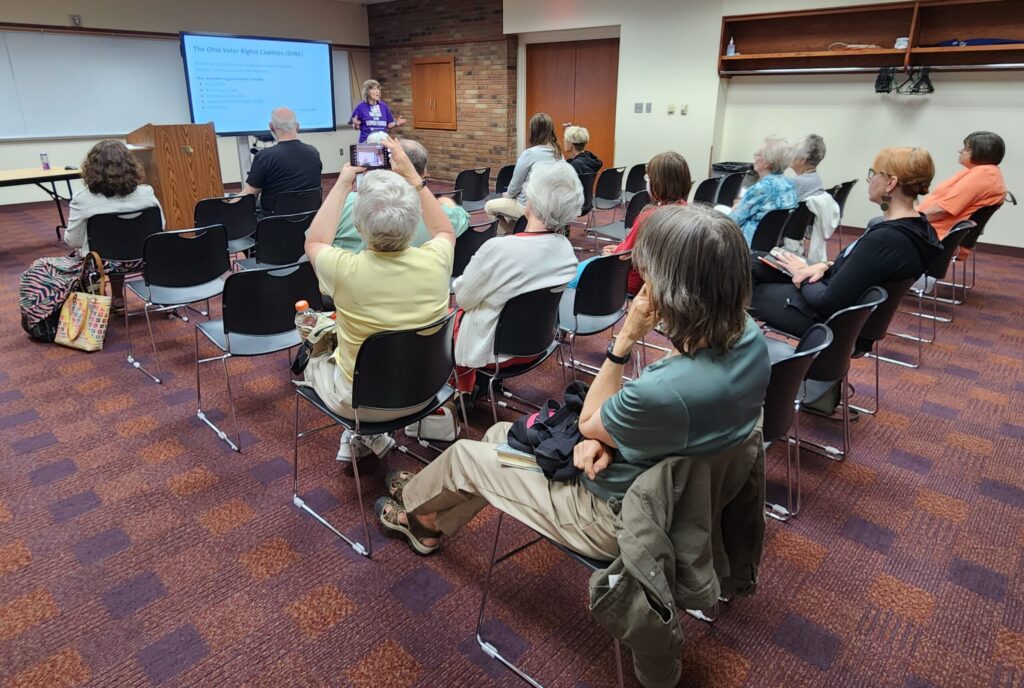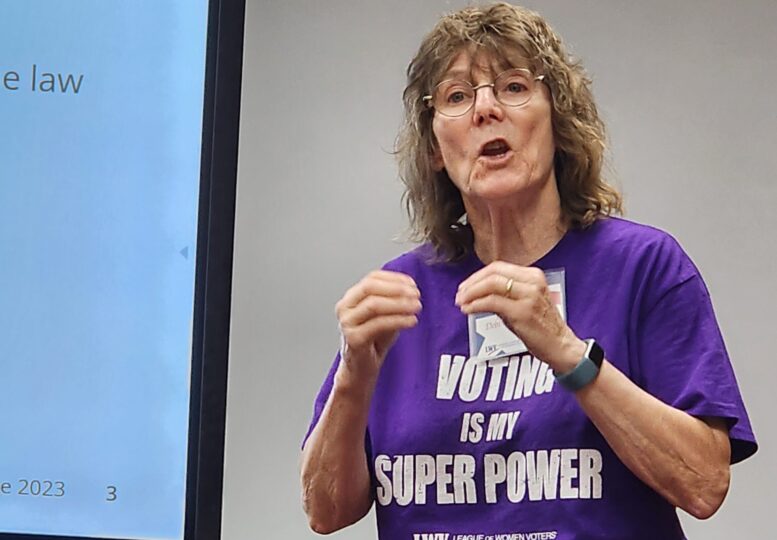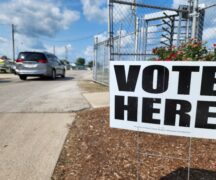By JAN LARSON McLAUGHLIN
BG Independent News
Wearing a shirt stating “Voting is my superpower,” Debbie Dalke led a meeting in Bowling Green last week to help voters be prepared for upcoming elections.
Ohio’s voter identification requirements have changed, and the Ohio Voter Rights Coalition wants to make sure the new rules don’t stop voters from casting their ballots.
Speaking at the Wood County District Public Library, Dalke represented a network of non-partisan voting advocates dedicated to modern, secure and accessible elections. The Ohio Voter Rights Coalition includes organizations like ACLU Ohio, All Voting is Local, Common Cause Ohio, League of Women Voters of Ohio, and Ohio Voice.
The most significant change to Ohio voting laws involves the identification needed for citizens showing up to cast their ballots.
“Our ID law is now among the strictest in the nation,” Dalke said.
The Ohio state legislators passed the new voting laws at the end of last year – “in a chaotic lame duck session,” Dalke said. “This was a very rushed job.”
Though not specifically noted in the legislation, Ohio Secretary of State Frank LaRose interpreted the new law to say that only one drop box for ballots would be permitted in each county, Dalke said. That means even in the most populous counties with more than 1 million residents, only one drop box would be available, she said.
People can still vote three ways – by mail, in person early, and in person on election day. To vote in person, a specific type of photo identification is now required, such as:
- Unexpired Ohio driver’s license.
- State of Ohio ID (not a student ID).
- U.S. military ID card.
- U.S. veterans ID (not county issued).
- Ohio National Guard ID card.
- Unexpired US passport.
“You now must have one of these,” Dalke said. The address on the ID does not need to match the voter registration address.
Free Ohio state ID cards are available from the Ohio BMV for those 17 or older.
Important to know in college towns like Bowling Green is the provision that out-of-state students getting an Ohio ID will invalidate their out-of-state drivers’ licenses. Out-of-state students can vote in person with a passport or by mail using a Social Security number as ID.
Polling locations on election day are based on the voters’ residences. “Younger voters don’t always know that,” Dalke said. “Clearly this is so important for communities where there are college students.”

Little has changed in Ohio with the voter registration process. Voters must be U.S. citizens, at least age 18 on the day of the general election, and a resident of Ohio for the last 30 days.
The registration deadline is typically 30 days prior to an election.
Voters who have missed consecutive elections can be purged from the polls, so Dalke urged people to make sure their names still appear on the voter rolls.
“We encourage people to check their voter registration status,” she said.
Dalke also reminded that voters must re-register once they have moved. Many young voters don’t realize that, she added.
Voting early at boards of election offices can be done in the month leading up to the election. So for the Aug. 8 election, early voting begins July 11. Citizens can vote early for a host of reasons, such as their work schedule, the desire to avoid long voting lines, or concerns about bad weather or last minute emergencies that may occur.
New rules are in place for voters using the drop box by the Board of Elections. Only specific close relatives can deliver the ballot for the voter – not including grandchildren or caregivers. Certain half-blood relatives are allowed to drop off the ballots, though Dalke pointed out that this provision seems unenforceable.
“This is what happens when you make a law in a rush,” she said.
Following are key dates for the statewide Aug. 8 election:
- July 10 is the voter registration deadline.
- July 11 early voting begins.
- Aug. 1 is the deadline to request an absentee ballot.
Absentee voting by mail
Dalke talked about the pros and cons of voting absentee by mail, with the advantage of not needing an Ohio driver’s license, and the disadvantage of it being more work and a greater likelihood that a mistake could result in the ballot being rejected.
To vote by mail, an application must be gotten from the Board of Elections (https://www.ohiosos.gov/elections/voters/absentee-voting/). The application must be returned to the Wood County Board of Elections no later than seven days before an election.
Provisional ballots
Provisional ballots are used when an issue must be resolved before a vote can be counted.
In the case of a voter forgetting to bring their ID to the polls, the provisional ballot will only be counted if the voter takes his or her ID to the Board of Elections within four days after the election.
Voters can call the Board of Elections to check on the status of the ballot.
Voting on election day (6:30 a.m. – 7:30 p.m.)
Polling locations are assigned to the address where the voter lives and is registered. If a voter is registered in Ohio but moved and did not update their voter registration, the person should:
- Go to polling location for new address.
- Update voter registration address.
- Vote a provisional ballot.
Hand-delivering ballots
Ballots must be hand delivered to the Board of Elections by 7:30 p.m. on election day. A drop box will be available, open 24 hours, during early voting. Only a specific close relative can deliver a ballot for a voter.
Mailed ballots
Mailed ballots must be postmarked by the day before the election and arrive at the Board of Elections by the fourth day after election day. Voters must pay postage for their ballots – one stamp per page.
Special voters
- Military/Overseas: Request and return ballot early. Ballots must be received by four days after election day.
- Hospitalized voters: Can submit applications to vote by mail until 3 p.m. on election day. Contact Board of Elections.
- People incarcerated for a felony cannot vote. All others in jail can vote.
Issue 1
Also at last week’s meeting on new voting laws in Ohio, Dalke talked about statewide Issue 1 on the Aug. 8 ballot. If approved, any future citizen-initiated change to Ohio’s constitution would require a supermajority of 60% – instead of the current 50% plus 1 required for passage now.
“That means 41% can stop a law that 59% of the voters want,” Dalke said.
Members of the League of Women Voters in Bowling Green voiced their concerns about Issue 1.
Janet Parks noted that the state legislature put Issue 1 on the Aug. 8 ballot after passing a law earlier this year that no state issues should appear on August ballots.
“At what point are we going to hold them accountable?” Parks asked, noting it’s the only issue appearing on the ballot. “That’s a complete waste of our money.”
Sheilah Crowley said she used to go into schools, talking to students about the importance of one vote. But if Issue 1 passes, one vote will no longer carry the same weight.
“That is the heartbreak of what this is all about,” Crowley said. “I’m afraid we’re raising a generation that’s not going to care about democracy. I’m concerned that just won’t matter anymore.”





